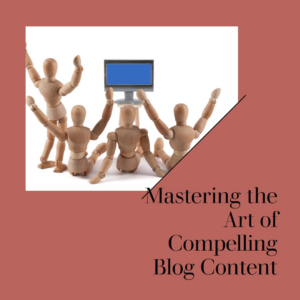Introduction:
In today’s content-saturated digital landscape, creating blog content that stands out and resonates with your audience is essential for driving traffic, engagement, and brand awareness. Compelling blog content goes beyond mere information; it captures readers’ attention, sparks curiosity, and inspires action. In this guide, we’ll explore essential tips and strategies for creating compelling blog content that captivates your audience, drives traffic to your website, and establishes your brand as a thought leader in your industry.

1. Know Your Audience:
Understanding your audience is the cornerstone of creating compelling blog content. Take the time to research and analyze your target audience’s demographics, interests, preferences, and pain points. Tailor your content to address their needs, aspirations, and challenges, and provide valuable insights, solutions, and inspiration that resonate with their interests and goals.
2. Choose Relevant and Timely Topics:
Stay abreast of industry trends, news, and developments, and choose topics that are relevant and timely to your audience. Address common questions, concerns, and misconceptions within your niche, and provide fresh perspectives, insights, and actionable advice that add value to your readers’ lives. Use tools like Google Trends, social media listening, and keyword research to identify popular topics and keywords that align with your audience’s interests and search intent.
3. Craft Compelling Headlines:
Your blog headline is the first thing readers see, so make it compelling and irresistible. Use power words, numbers, and adjectives to pique curiosity and evoke emotion. Promise a clear benefit or solution to entice readers to click and explore further. Experiment with different headline formulas, such as listicles, how-tos, questions, and statistics, to find what resonates best with your audience.
4. Create Engaging and Readable Content:
Capture readers’ attention from the outset with an engaging introduction that hooks them into your content. Use storytelling, anecdotes, or compelling statistics to draw readers in and establish a connection. Break up your content into bite-sized paragraphs, use subheadings, bullet points, and images to improve readability and comprehension. Keep your language clear, concise, and conversational, avoiding jargon or overly technical terms that may alienate readers.
5. Provide Value and Unique Insights:
Deliver value to your audience by providing unique insights, expertise, or perspectives that differentiate your content from competitors. Offer practical tips, strategies, or actionable advice that readers can implement immediately to solve their problems or achieve their goals. Share personal experiences, case studies, or real-life examples to illustrate key points and make your content relatable and authentic.
6. Incorporate Multimedia Elements:
Enhance the visual appeal and engagement of your blog content by incorporating multimedia elements such as images, infographics, videos, or interactive elements. Use visuals to break up text, illustrate concepts, and make your content more visually appealing and memorable. Leverage multimedia formats to cater to different learning styles and preferences and provide a richer, more immersive experience for your readers.
7. Encourage Interaction and Feedback:
Foster a sense of community and engagement by encouraging readers to interact with your content and share their thoughts, questions, or experiences in the comments section. Pose questions, prompts, or calls-to-action to spark discussion and invite reader participation. Respond promptly to comments, answer questions, and acknowledge feedback to demonstrate your engagement and appreciation for your audience’s input.
8. Optimize for SEO:
Optimize your blog content for search engines to improve visibility and attract organic traffic to your website. Conduct keyword research to identify relevant keywords and phrases related to your topic, and incorporate them strategically into your content, headings, and meta tags. Write descriptive meta descriptions and optimize your URL structure to improve click-through rates and maximize your content’s discoverability and ranking potential.
Conclusion:
Creating compelling blog content is both an art and a science, requiring a deep understanding of your audience, creativity, and strategic execution. By knowing your audience, choosing relevant topics, crafting compelling headlines, creating engaging and readable content, providing unique insights, incorporating multimedia elements, encouraging interaction, and optimizing for SEO, you can create blog content that captivates your audience, drives engagement, and positions your brand as a trusted authority in your industry.



